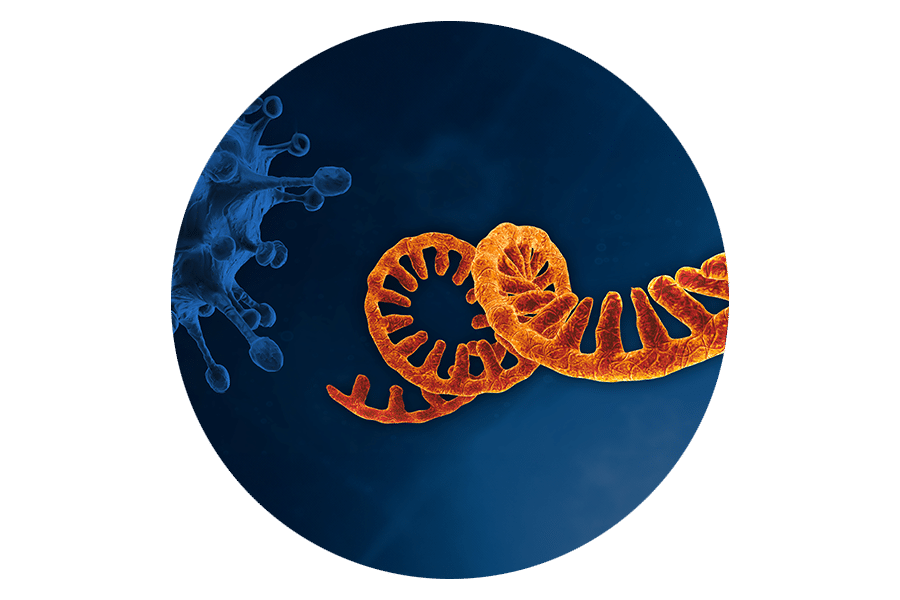HiFi sequencing can take your research to the next level, from discovery through the development process
DNA sequencing has become a commonly used tool across the biologics research and development process. While next generation sequencing (NGS) is routinely used, there remain challenges and limitations of the method given its short read lengths. Other long-read methods suffer from lower accuracy that may make alignment of reads difficult and cause you to miss out on valuable information. HiFi long-read sequencing overcomes many of these limitations while maintaining Sanger-level accuracy to empower your work with powerful tools.
HiFi sequencing can elevate some of the most commonly used approaches in biologics research and development:
Plasmids
Capture and verify the full length of your plasmid at Sanger-level accuracy
Plasmids play a vital role in biologics research and development. Since many plasmids may contain errors or be incorrectly annotated*, carefully sequencing the full plasmid including backbone is an important step to maintaining integrity of your research.
Traditional Sanger sequencing is limited to confirming insert sequences or may involve complex primer walking. With HiFi sequencing, you can sequence full-length plasmids —including backbone, promoters, resistance genes, and gene inserts — without relying on a reference sequence. Owning a PacBio instrument in-house reduces turnaround time and enhances data and IP security.
The PacBio advantage:
- Sequence full plasmids with Sanger-level accuracy and long read lengths
- Achieve uniform coverage across repetitive regions, homopolymers, and GC-rich regions that pose challenges for other sequencing methods
- Accelerate turnaround times and increase data security with in-house sequencing
*Bai X, Hong JF, Yu S, et al (2024) Prevalence of errors in lab-made plasmids across the globe. bioRxiv 2024.06.17.596931. https://doi.org/10.1101/2024.06.17.596931


Cell lines and master cell banks
Confirm genomic integrity at scale
Master cell banks and cell lines are critical components of biologics research and development. Every cell line and master cell bank needs to be assessed for identity and genomic integrity in regular intervals, especially where they are used as a tool to create biologics.
Ensuring genomic integrity is paramount for quality and safety. HiFi whole genome sequencing offers exceptional accuracy and turnaround time, enabling precise assessment of genomic integrity and variation, instilling the utmost confidence in your results.
The PacBio advantage:
- Accelerate your discovery and development with faster, more accurate, and more comprehensive results than other technologies
- Generate phased genomes with 5mC methylation information and structural variant calling to ensure high-quality starting materials and to avoid costly failures
mRNA vaccine research
Overcome common research challenges with characterizing mRNA identity and poly(A) tail length
Following the COVID-19 pandemic, mRNA vaccines have emerged as effective tools against infectious diseases and show potential as cancer treatments. Vital considerations for mRNA-based vaccine stability and efficacy include mRNA integrity and the length of its poly(A) tail.
Characterize your mRNA at full length
PacBio long-read sequencing allows you to capture the full length of your transcript at single-molecule resolution, giving you isoform-level information at base-level accuracy.*,**
Confidently sequence homopolymers such as poly(A)
In contrast to other methods, HiFI sequencing has the ability to accurately sequence long homopolymers such as full-length poly(A) tails. This allows you to determine the length distribution of mRNA molecules as an important determinant for vaccine efficacy.
The PacBio advantage:
- Sequence full-length mRNA at high accuracy to determine size and isoform distribution to most confidently assess your research products
- Characterize homopolymers such as poly(A) regions more accurately than with other sequencing methods to optimize your construct and process
*Legnini I, Alles J, Karaiskos N, et al (2019) FLAM-seq: full-length mRNA sequencing reveals principles of poly(A) tail length control. Nat Methods 16:879–886. https://doi.org/10.1038/s41592-019-0503-y
** Liu Y, Nie H, Liu H, Lu F (2019) Poly(A) inclusive RNA isoform sequencing (PAIso−seq) reveals wide-spread non-adenosine residues within RNA poly(A) tails. Nat Commun 10:5292. https://doi.org/10.1038/s41467-019-13228-9


Protein directed evolution
Increase the variety of mutations or domain shuffling strategies through long read lengths to add greater power to your directed evolution approaches
Directed evolution approaches such as phage display and others are a common and popular tool to develop proteins with desired properties.
The size of the region that can be tested and optimized may be very limited when using short-read sequencing, which in turn poses limits on the diversity of constructs that can be tested and optimized.
Other long-read methods may lack the accuracy to accurately align and assign barcodes to variants in the library and therefore can lead to a loss of usable data.
Overcome these limitations by using targeted long-read sequencing such as amplicon or plasmid sequencing to allow for greater variety of approaches and diversity of libraries that are accessible to your research.
A team at UT Southwestern used HiFi long-read sequencing and domain shuffling, which allowed them to introduce mutations in the cap gene of the AAV capsid in a much longer region. This lead to the discovery of several interesting candidates for novel capsid proteins with desired tissue specificity to the central nervous system.
Casy W, Garza IT, Chen X, et al (2023) SMRT Sequencing Enables High-Throughput Identification of Novel AAVs from Capsid Shuffling and Directed Evolution. Genes 14:1660. https://doi.org/10.3390/genes14081660
Brochure
HiFi solutions for cell and gene therapy research
Explore how HiFi sequencing can be used to support your gene and cell therapy research.


